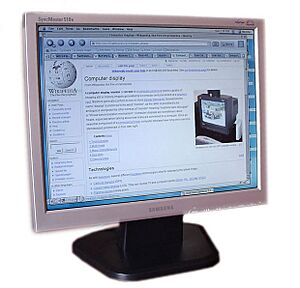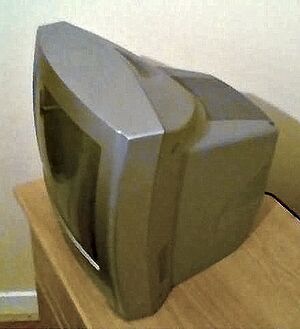Thin film transistor liquid crystal display facts for kids
A thin film transistor liquid crystal display (often called TFT-LCD or just TFT) is a special kind of screen. You can find these screens in many things, like computer monitors and televisions. TFT technology helps make very clear pictures on flat screens. It also uses much less electricity than older types of screens.
TFT displays are made to be very thin and light. This means they don't take up much space. But it also means they can be a bit fragile. These screens are also known as flatscreen or flat-panel displays. While all TFTs are LCDs, not all LCDs use TFT technology.
Many modern TVs and monitors use widescreen displays. These screens have a shape called a 16:9 aspect ratio. For a long time, standard screens with a 4:3 aspect ratio were the most common.
TFT displays are made using a special process called chemical vapor deposition. This process helps coat very thin glass with metal that can conduct electricity. Even with this coating, the glass stays clear. This is how the thinnest computer and TV screens are made.
Contents
Screen Detail (Resolution)
The number of tiny dots on a screen is called its resolution. These tiny dots are known as pixels. A screen with a better resolution can show a more detailed picture. Each pixel adds more detail to what you see.
Resolution is usually described by two numbers. For example, 1920 x 1080 means the screen has 1920 pixels going across and 1080 pixels going down.
Making Pictures (Rendering)
Most screens have millions of pixels. Each pixel needs to show the right color. Many screens can show over 16 million colors for each pixel! To make a clear picture, the screen's processor has to do many calculations.
But the processor is smart. If many pixels need to be the same color, it can change them all with just one calculation. For example, if the screen is all white, the processor only calculates the color once. Then it uses that same calculation for the whole screen. This saves a lot of work.
If the same picture appears many times on the screen, the processor calculates it once. Then it just repeats that picture where needed, even at different sizes. This smart way of making pictures is called rendering technology. It's like making a mosaic where you reuse the same tiles.
Imagine a screen with 1600 x 1200 pixels. This screen has four times more pixels than an 800 x 600 screen. Without rendering technology, the bigger screen would need to do four times more work. Rendering technology helps bigger screens work well using similar parts to smaller ones.
TFT vs. Older CRT Screens
For a long time, people used big, bulky screens called CRT displays. TFT screens are much newer and have many advantages.
Here are some good things about TFT displays:
- They are easier to make and use less electricity.
- They can have more pixels, meaning a higher resolution.
- They produce less radiation.
- They use digital signals, which are clearer.
- It's easier to make them in the popular 16:9 widescreen shape.
Here are some things that used to be seen as downsides for TFTs, but are less true now:
- Early TFT screens sometimes looked dark if you viewed them from the side. This is much better in modern TFTs.
Here are some good things about older CRT displays (which are mostly not true anymore):
- They used to be cheaper to buy.
- Their colors used to look very clear from all angles.
Here are some bad things about CRT displays:
- They are very big and heavy.
- They use a lot more electricity.
- They make a lot of heat.
- They can be affected by electrical wires nearby. If wires were too close, the colors might look wrong.
TN Panels
TN stands for Twisted Nematic. This is a newer type of TFT technology. TN panels can offer even higher resolutions, meaning more pixels. They also have a lower response time, which means they can react faster to changes on the screen. This is good for fast-moving videos or games.
Further development
Since this article was written, screen technology keeps getting better! For more up-to-date information, you can check out the main Wikipedia page about Computer Monitors.
Images for kids
See also
 In Spanish: TFT LCD para niños
In Spanish: TFT LCD para niños




